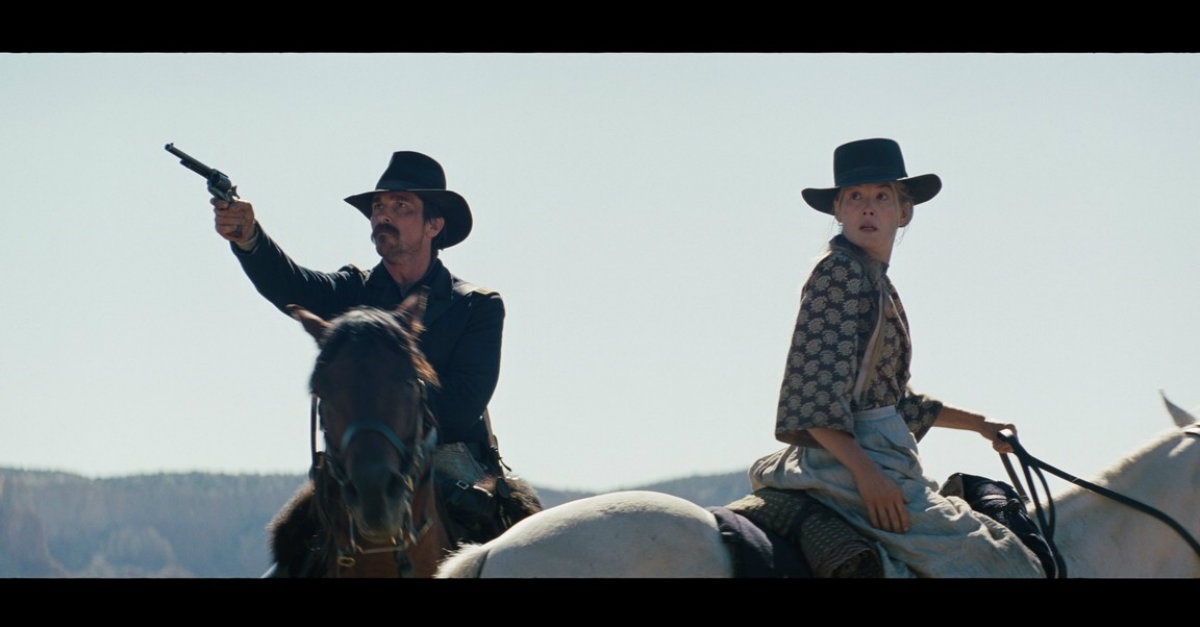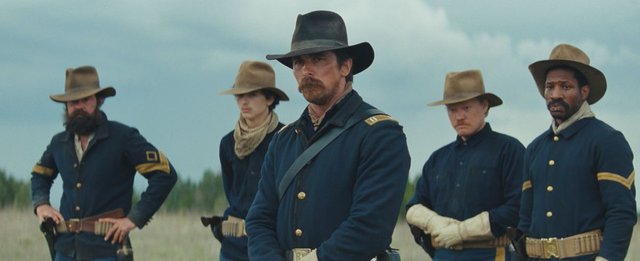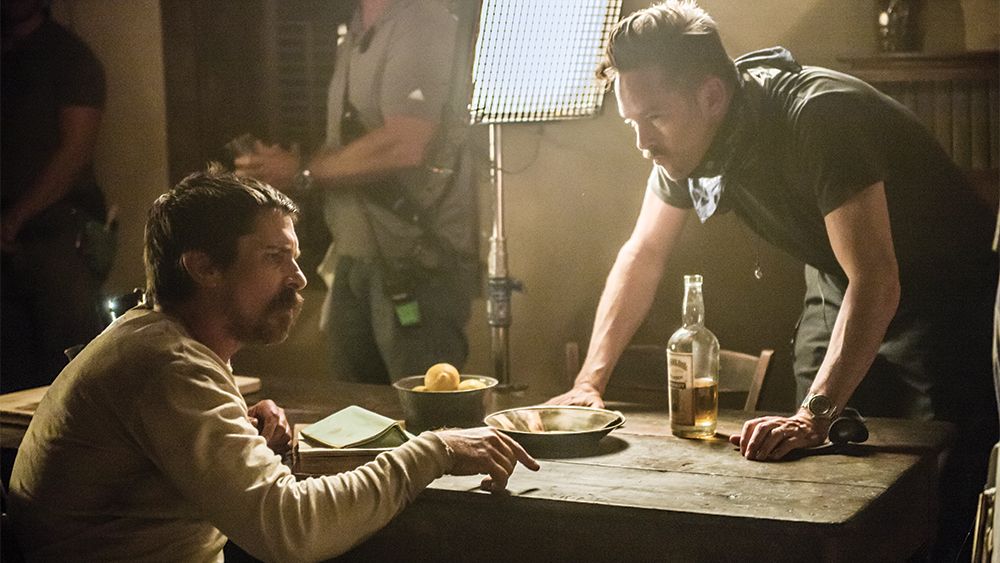Hostiles is the latest entry into Scott Cooper’s impressive film slate (alongside Crazy Heart and Black Mass). U.S. Cavalry Captain Joe Blocker (Christian Bale) is tasked with escorting Cheyenne Chief Yellow Hawk (Wes Studi) and his family to their ancestral home in Montana. Along the way, they pick up Rosalie Quaid (Rosamund Pike), the victim of a Comanche massacre, and Blocker is slowly forced to confront his virulent hatred of all Native Americans.
Where Hostiles is strong, it’s as strong as the windswept plains and unforgiving wilds of the frontier West. Like any good western, the setting is the biggest character in the film and the outdoor, naturally-lit shooting locations would make even the most committed city folk long for a horseback excursion into the wilderness. The strongest point is Hostiles’ varied and thorough approach to PTSD. Almost every major character presents different symptoms and responses, from the unhealthiest depression to a fully processed grief resolved by the end of the film.

Our initial introduction to Blocker and his best friend, Master Sergeant Thomas Metz (Rory Cochrane) is a frank discussion between the two hardened veterans about Metz’s feeling that he is too depressed to continue soldiering and doesn’t believe they’ve done the right thing in the American Indian Wars. Joe, our resident PTSD-denier, doesn’t believe that “melancholia” is a real thing, despite being visibly ragged and repressive.
We later meet Rosalie, who goes from shock, to numb grief, to anger, and finally to picking herself up and confronting her fears with her chin held high. All three characters confront suicide in a similar manner, but with different ends for different reasons.
Another reviewer described Rosalie’s unhinged, wild grief as “deranged,” which is something I take umbrage to. It was hard to watch yet pleasantly surprising that they allowed such a beautiful actress to express ugly emotions on screen. I would challenge anyone who disagrees to live through half of the brutal massacre she survives at the start of the film and come out on the other side still pretty and in control of all their faculties. PTSD and trauma aren’t pretty.
For his part, Joe displays one of the most sensitive and considerate responses to a shell-shocked person I think I’ve ever seen on film. Rosalie is deep in her grief-induced delusion and Joe never even pauses or breaks stride with her. Each time her crazy spikes – and it is unquestionably heartbreaking to watch for anyone who’s ever confronted even a fraction of that brand of trauma and grief – he rolls with it and helps his soldiers help her. There was something oddly comforting from the audience perspective to see someone in so much pain get exactly the support she needed. We should all be so lucky to have a friend like Joe Blocker around in an emotional crisis. I think it’s important to show strong, masculine characters behaving with emotional intelligence and empathy that’s never questioned, never undermined (no asinine “This is womenfolk stuff” commentary), and is as natural as the spring monsoons. For a man who professed to not believe in melancholia, he is awfully quick to know how best to help Rosalie, in a way that suggests he has dealt with this many times over.
This is where I’m going to have to get critical and buckle up because it’s a long one. Almost as long as this movie. Feel free to skip to the end for my official woobie rating.
There are some minor, but hopefully oblique, spoilers below
Hostiles is about an hour too long. In addition to the sprawling central conflict (Joe hates Native Americans but must escort this family safely across nearly 900 miles of untamed territory), there are three separate and distinct sets of antagonists who never intersect. Actually, there are four, but two of them intersect, so I’ll count them as one. Each set of bad guys is given its own act, with a complete plot development, before moving onto the next one. I found myself wondering why these three aggressors couldn’t be refined into a single, coherent narrative, or at least intersect in some way. During their journey, they take on prisoner Sergeant Charlie Wills (Ben Foster), a fellow veteran of the American Indian Wars, accused of committing an unauthorized massacre, who spends most of his time on screen reminding Joe and Metz that they all committed similar massacres and are not better than him. This would have been a great antagonist to carry through the film, challenging Joe’s sense of righteousness and his burgeoning empathy for the Cheyenne. Instead, he’s confined to his own act and gone before he’s been there long enough to really make an impact. He doesn’t change Joe, who is already on the high road, or Metz, who has already made a big decision about the course of his life. Wills has no impact, yet we spend a goodly chunk of an overlong film on him.
Because the film clods along for almost two and a half hours, even the genuine exploration of PTSD, trauma, and anger eventually become heavy-handed. As much as I felt the depth of each soul-crushing, intense speech about the nature of man and violence, after a certain point, Metz became “a sentient beard chiming in to remind us that we’re watching a morally tortured American western.” I love a sentient beard as much as the next person, but egads.
Corporal Woodson is one of three major shortfalls in Hostiles. As a Buffalo Soldier, I was certain we were building to some kind of narrative commentary on his background in the post-Civil War Union Cavalry juxtaposed against his literally putting chains on people. Instead, the fact that he was almost definitely the son of slaves is never broached. Woodson is ever the stoic, loyal soldier who never questions his captain’s orders, the treatment of the Cheyenne, nothing.

Woodson exists in the narrative purely to tell the audience how not-bigoted Blocker is because Blocker loves him unconditionally and treats him as a soldier, not a black man in mid-19th century America. Woodson appears to serve as the black friend all self-denying racists insist they have. It was not only a missed opportunity (they chose the only black guy to put chains on the Cheyenne! And it was never addressed!) but it only served to further highlight the fact that every person of color in this film exists to make Blocker a better person.
The second shortfall builds on the treatment of Woodson: the Cheyenne characters were not only the ultra-racist “stoic natives” trope, but had no development, almost no lines, and like Woodson only appeared on screen to help Blocker grow. I am going to break from my fellow liberal reviewers and say that I don’t mind that the film focuses on Blocker. Films have to focus on someone, and I don’t think the choice to focus on Blocker is inherently bad, even if I wish more films chose to focus on other demographics. It was satisfying to watch Blocker gradually ease out of his destructive hate, but it would have been so much more satisfying if it had been alongside people who weren’t holding his hand and coaxing him into it. The Cheyenne characters didn’t need to be wise or kind or generous of spirit to still be valid human beings who deserved humane treatment. They didn’t have to earn his grudging acceptance by being paragons of virtue. Sadly, Hostiles doesn’t seem to think so. Considering this film is one big study on gray morality, it would have been nice to extend that kind of complicated, dynamic development to the characters who were ostensibly the most important part of Blocker’s story. Blocker’s redemption couldn’t exist without them, did they not also rate more than five minutes of speaking time?
The final shortfall was so severe it has made Hostiles leave a bad taste in my mouth: that ending. I was rolling along with the film up until the climax. Hostiles simultaneously makes the same mistake that The Walking Dead makes over and over again, and then caps the whole thing off with an ending so blissfully ignorant it can only be described as “white nonsense.” The ending is at turns unnecessarily harsh and overly soft, adding up to a resolution that is deeply unsatisfying. Without giving too much away, I’ll say that I stopped watching The Walking Dead because I got real sick and tired of “lol, everyone can die at any time for no reason and it never furthers the plot! Because the world is unfair and we’re so0o00oo0o edgy!” Because of the insane popularity of that show, it is uber-trendy to kill off 99% of your cast with total disregard to story development and call it deep, challenging, or thought-provoking. I disagree with that trend. I think it’s this generation’s deus ex machina parading as gritty commentary on life. Hostiles does basically that for no reason at all. Up to the ending, so many characters have died that the act of burying people is actually a running motif that closes each act of the film. It’s not like we, the audience, don’t have a grasp on the brutality of the American frontier and the fruitlessness of violent conflict. We get it, fam. We got it four dead guys ago.
If the film had ended right there, it might not have been so bad: a bleak ending for a bleak film. But then it doesn’t stop there. Hostiles couldn’t just let it be dark, oh no.

Director Scott Cooper with Christian Bale
SPOILER ALERT!
The white survivors get to start a new family by taking the silent (he doesn’t get a say in this) surviving Cheyenne child and raising him as their own in Chicago. Yup, you read that right. The entire film is centered around getting these people back to their homeland and they end it by taking that child out of his native home and raising him in Chicago with white people. They could have just stayed in Montana, journey complete! Mission (sort of) accomplished! This beautiful moment of Blocker putting his life on the line to defend the people he hated at the start of the film could have remained pure in its tragedy. Instead, the ending felt bereft and unsatisfying.
Every single character who died trying to get this family to Montana died so this white couple could fade-to-black while starting down a path that was one of the quieter atrocities of the settlement of the American West: that time tens of thousands of native children were taken from their families and homes to be raised by white people in abusive, degrading orphanages. “Kill the Indian, save the man” was the motto. The film centers around the close of the worst of the American Indian Wars, which means it deals with the beginning of what was called “the Indian problem,” wherein the solution was forced marches to desolate, untenable reservations and the all-out theft of Native American children to be raised as white people. The fact that the filmmakers were so blithely unaware of the horrifying implications of this ending would be funny if it wasn’t so disappointing. The ending managed to be glaringly ignorant and undermine the entire struggle at the center of the film: help these people return to their land, find peace. Or not.
The Magnificent Seven (2016) dealt with all the same subject matter: beautiful cinematography, shootouts, bigotry, politics, and war/violence-induced PTSD with tighter pacing, better dialogue, more likEable characters, and an ending that perfectly matched the subject matter without shooting itself in the foot. Sorry. I’m not that sorry.
3 OUT OF 5
I’m giving this one 3 woobies of a potential 5 for its thorough portrayal of the spectrum of PTSD symptoms and response, cinematography, and the earnest if faulty attempt to tackle complicated racial and political issues.